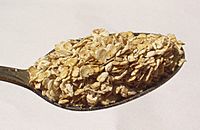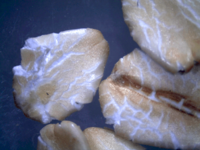Rolled oats facts for kids
| Nutritional value per 100 g (3.5 oz) | |
|---|---|
| Energy | 379 kcal (1,590 kJ) |
|
67.70 g
|
|
| Sugars | 0.99 g |
| Dietary fiber | 10.1 g |
|
6.52 g
|
|
|
Protein
|
13.15 g
|
| Vitamins | Quantity
%DV†
|
| Vitamin A equiv. |
0%
0 μg |
| Thiamine (B1) |
40%
0.460 mg |
| Riboflavin (B2) |
13%
0.155 mg |
| Niacin (B3) |
7%
1.125 mg |
| Pantothenic acid (B5) |
22%
1.120 mg |
| Vitamin B6 |
8%
0.1 mg |
| Folate (B9) |
8%
32 μg |
| Vitamin B12 |
0%
0.00 μg |
| Choline |
8%
40.4 mg |
| Vitamin C |
0%
0 mg |
| Vitamin D |
0%
0 μg |
| Vitamin E |
3%
0.42 mg |
| Vitamin K |
2%
2.0 μg |
| Minerals | Quantity
%DV†
|
| Calcium |
5%
52 mg |
| Iron |
33%
4.25 mg |
| Magnesium |
39%
138 mg |
| Manganese |
173%
3.630 mg |
| Phosphorus |
59%
410 mg |
| Potassium |
12%
362 mg |
| Sodium |
0%
6 mg |
| Zinc |
38%
3.64 mg |
| Other constituents | Quantity |
| β-glucan (soluble fibre) | 4 g |
|
Full Link to USDA Database entry
|
|
| †Percentages estimated using US recommendations for adults. | |
Rolled oats are a popular whole-grain food. They are made from oat grains that have been prepared in a special way. First, the outer shell is removed. Then, the oats are steamed. After steaming, they are flattened into thin flakes using heavy rollers. Finally, they are lightly toasted to make them last longer.
There are different kinds of rolled oats. Thick-rolled oats are large, whole flakes. Thin-rolled oats are smaller pieces. If you cook whole rolled oats, they become a warm cereal called porridge. These are sometimes called old-fashioned oats or Scottish oats. Other types, like "quick" or "instant" oats, are processed more. This makes them absorb water faster and cook very quickly.
Besides porridge, rolled oats are often a main ingredient in granola and muesli. They can also be ground into a coarse powder. When cooked, this powder becomes a thick liquid. Very fine oat powder is sometimes used as baby food.
Contents
How Rolled Oats Are Made
Making rolled oats starts with the oat grain itself. Like other cereal grains, oats have a tough outer shell called a husk. This husk cannot be eaten and must be taken off. After the husk is removed, what's left is called an oat groat.
Oat groats still have a layer called the bran. The bran is healthy, but it can make the oats hard to chew. It also contains an enzyme that can make the oats go bad quickly. To fix this, raw oat groats are often steamed. Steaming makes them softer so they cook faster. It also stops the enzyme from working, which helps the oats stay fresh longer on the shelf.
Steel-Cut Oats Explained
Steel-cut oats are a bit different. They are oat groats that are chopped into smaller pieces. This happens before they are steamed. Because they are chopped before steaming, they still have bits of the bran layer. This gives them a chewier texture.
Cooking and Eating Rolled Oats
You can eat rolled oats without cooking them! To do this, you soak them in a liquid like water, milk, or a plant-based drink. You usually soak them for 1 to 6 hours. How long you soak them depends on their size and how they were processed. Soaking saves cooking time and energy. It also helps keep their natural taste and nutrients.
Traditionally, oat groats are a whole grain that can be eaten for breakfast. Just like different kinds of oatmeal, rolled oats can be cooked to make a warm porridge. Rolled oats are also used in many other foods. You can find them in granola, muesli, oatcakes, and flapjacks. Flapjacks are like a chewy granola bar.
Nutrients in Rolled Oats
Whole oats that are not cooked are full of good things for your body. For every 100 grams, they have about 68% carbohydrates, 6% fat, and 13% protein. This amount of oats gives you 379 calories of energy.
Rolled oats are also packed with B vitamins. They have a lot of thiamine and pantothenic acid. They are also rich in several important dietary minerals. These include a lot of manganese and phosphorus.
Oats are a great source of dietary fiber. For every 100 grams, they provide 10 grams of fiber. A special type of fiber in oats is called beta-glucan. You get about 4 grams of beta-glucan per 100 grams of oats. Beta-glucan is a soluble fiber that can help lower cholesterol levels in your body.
hu:Zabpehely ro:Fulgi de ovăz
See also
 In Spanish: Copos de avena para niños
In Spanish: Copos de avena para niños



